
DRSSTC - strange phase inversion on bridge o/p
chris_inkubate, Sat Sept 27 2014, 05:47PMHi all,
I've been doing some testing of my bridge output with a 48V bus supply and now using brick IGBT's with UD2.5. However i'm getting a strange effect - my bridge output is inverting its phase just over half way through the on cycle. At the same point my current waveform starts to ring down. I suspect that the inversion of the waveform is then pulling the output down or is this an effect of some kind of ring down on the feedback phase? I have tried with and without the phase lead inductor in the circuit and get the same issue. Also it seems my bridge has a DC level. This may be my scope though as its a PC scope on a laptop so I'm measuring the bridge o/p with one channel.
Any thoughts would be most appreciated as I'm stumped and don't want to turn up my bus voltage not knowing! Many Thanks.
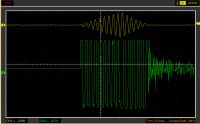
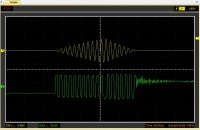
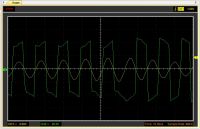
Re: DRSSTC - strange phase inversion on bridge o/p
Mads Barnkob, Sat Sept 27 2014, 07:15PM
At the peak of the current waveform is where the switches stop conducting and the ring down of the current is the energy returning to your DC bus capacitors through the diodes in the switches as is can be seen in the inverter waveform.
The elevated DC level on your inverter output could be residual charge in your MMC and it is possible that it will make your inverter run unstable. A resistor across the output of the inverter can help burn this residual charge between the bursts. Look at this thread: and read this paper on the issue by Steve Ward:
and read this paper on the issue by Steve Ward: 
You really should get a decent oscilloscope, the Rigol DSO series are really good equipment to the money or you can try to look for a cheaper old analogue oscilloscope. The PC oscilloscope is simply too slow and take too few samples to show all the transients and glitches that you really would like to see, so you can do something about it and see that they are gone.
Your waveforms are simply too good looking to be true ;)
Mads Barnkob, Sat Sept 27 2014, 07:15PM
At the peak of the current waveform is where the switches stop conducting and the ring down of the current is the energy returning to your DC bus capacitors through the diodes in the switches as is can be seen in the inverter waveform.
The elevated DC level on your inverter output could be residual charge in your MMC and it is possible that it will make your inverter run unstable. A resistor across the output of the inverter can help burn this residual charge between the bursts. Look at this thread:
 and read this paper on the issue by Steve Ward:
and read this paper on the issue by Steve Ward: 
You really should get a decent oscilloscope, the Rigol DSO series are really good equipment to the money or you can try to look for a cheaper old analogue oscilloscope. The PC oscilloscope is simply too slow and take too few samples to show all the transients and glitches that you really would like to see, so you can do something about it and see that they are gone.
Your waveforms are simply too good looking to be true ;)
Re: DRSSTC - strange phase inversion on bridge o/p
chris_inkubate, Sat Sept 27 2014, 07:42PM
I see so that is the point where the interrupter shuts off and of course the return is in the opposite direction and hence phase. Thats makes sense thanks. I'll look at those articles too as it seems with DRSST'ing that something new is seen every time I do some testing but its all interesting stuff.
I'll probably get an older scope as that'll be easier on my finances. I have access to a Tektronix TDS210 at work but its quite an old digital scope so not sure how well it'll do. I did start to think I was missing something as there was no change in the waveform with the inductor adjustment in way of ringing - just movement of the waveform phase.
chris_inkubate, Sat Sept 27 2014, 07:42PM
I see so that is the point where the interrupter shuts off and of course the return is in the opposite direction and hence phase. Thats makes sense thanks. I'll look at those articles too as it seems with DRSST'ing that something new is seen every time I do some testing but its all interesting stuff.
I'll probably get an older scope as that'll be easier on my finances. I have access to a Tektronix TDS210 at work but its quite an old digital scope so not sure how well it'll do. I did start to think I was missing something as there was no change in the waveform with the inductor adjustment in way of ringing - just movement of the waveform phase.
Re: DRSSTC - strange phase inversion on bridge o/p
chris_inkubate, Sat Oct 11 2014, 07:54PM
I have now got access to a faster and higher sampling rate oscilloscope and have now managed to see the masses of ringing present with no phase lead particularly. I've tweaked my phase lead now and have managed to eliminate the large fast spikes at the starts of the square waves, but as the cycle progresses there is another anomaly forming as the wave shape gets very messy and jagged along the peaks. Its not peaking any higher than the bridge voltage so not worried as such but curious as to if its an indicator of something else. Below waveforms are with phase lead set for minimum spikes (I will be trying a slightly lower value inductor as the centre ferrite screw is almost full out to get this!). Many Thanks, Chris
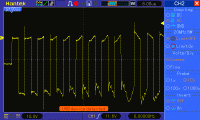
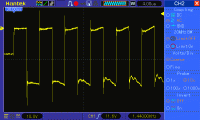
chris_inkubate, Sat Oct 11 2014, 07:54PM
I have now got access to a faster and higher sampling rate oscilloscope and have now managed to see the masses of ringing present with no phase lead particularly. I've tweaked my phase lead now and have managed to eliminate the large fast spikes at the starts of the square waves, but as the cycle progresses there is another anomaly forming as the wave shape gets very messy and jagged along the peaks. Its not peaking any higher than the bridge voltage so not worried as such but curious as to if its an indicator of something else. Below waveforms are with phase lead set for minimum spikes (I will be trying a slightly lower value inductor as the centre ferrite screw is almost full out to get this!). Many Thanks, Chris


Re: DRSSTC - strange phase inversion on bridge o/p
loneoceans, Sun Oct 12 2014, 12:28AM
That's normal behavior :) Scroll to somewhere near the middle here: which explains the shape as well as a guide to choosing the right parameters.
which explains the shape as well as a guide to choosing the right parameters.
loneoceans, Sun Oct 12 2014, 12:28AM
That's normal behavior :) Scroll to somewhere near the middle here:
 which explains the shape as well as a guide to choosing the right parameters.
which explains the shape as well as a guide to choosing the right parameters.Re: DRSSTC - strange phase inversion on bridge o/p
chris_inkubate, Sun Oct 12 2014, 10:33AM
Thanks for that so this is the sag you mention as a result of primary current & ohms law.
I can see that on your scope shots although mine is little more jagged. I think I'll be happy as long as I can avoid any destructive peaks! I'll be trying to scope my bus and gate together today as that didn't work for some reason yesterday (although it was late so could have messed up) and see how that coincides with Loneoceans advice.
chris_inkubate, Sun Oct 12 2014, 10:33AM
Thanks for that so this is the sag you mention as a result of primary current & ohms law.
I can see that on your scope shots although mine is little more jagged. I think I'll be happy as long as I can avoid any destructive peaks! I'll be trying to scope my bus and gate together today as that didn't work for some reason yesterday (although it was late so could have messed up) and see how that coincides with Loneoceans advice.
Re: DRSSTC - strange phase inversion on bridge o/p
Goodchild, Tue Oct 14 2014, 02:50PM
Chris the phase inversion you are seeing is the point at which you are turning your interrupter off. What's happening is that when the interrupter goes low this turns off all the IGBTs on the next zero current crossing, however there is still a massive amount of energy still in the primary LC, so what happens is the co-pack diodes in the IGBTs take over and start to rectify the remaining energy back into the bus capacitor.
Simply put the phase inversion is the point at which the IGBTs stop switching and the diodes take over.
Overall your waveform have a normal amount of ringing, nothing to worry about. The slanting of the pulses is due to the ESR of your bus capacitor. Lower ESR capacitors will present less of a slant in the pulse as you go higher in primary current.This is not necessary an issue if your bus cap isn't getting excessively hot.
Hope this helps,
Eric
Goodchild, Tue Oct 14 2014, 02:50PM
Chris the phase inversion you are seeing is the point at which you are turning your interrupter off. What's happening is that when the interrupter goes low this turns off all the IGBTs on the next zero current crossing, however there is still a massive amount of energy still in the primary LC, so what happens is the co-pack diodes in the IGBTs take over and start to rectify the remaining energy back into the bus capacitor.
Simply put the phase inversion is the point at which the IGBTs stop switching and the diodes take over.
Overall your waveform have a normal amount of ringing, nothing to worry about. The slanting of the pulses is due to the ESR of your bus capacitor. Lower ESR capacitors will present less of a slant in the pulse as you go higher in primary current.This is not necessary an issue if your bus cap isn't getting excessively hot.
Hope this helps,
Eric
Re: DRSSTC - strange phase inversion on bridge o/p
chris_inkubate, Tue Oct 14 2014, 07:02PM
Thanks for the additional information. Its making more sense now. Just lots of tuning now although I think with my larger tank cap its taking more peak current to get the same length sparks as before but from what I've read this isn't unusual due to lower primary impedance. I'll have to see what happens and check my average power.
chris_inkubate, Tue Oct 14 2014, 07:02PM
Thanks for the additional information. Its making more sense now. Just lots of tuning now although I think with my larger tank cap its taking more peak current to get the same length sparks as before but from what I've read this isn't unusual due to lower primary impedance. I'll have to see what happens and check my average power.
Re: DRSSTC - strange phase inversion on bridge o/p
Goodchild, Wed Oct 15 2014, 01:47AM
This has been my experience as well. Typically you can get long sparks in either scenario (high or low impedance tank), however I typically favor a tank impedance > 10ohms, it makes the system more controllable and runs lower peak currents. The lower peak current can be less stressful on your MMC and bridge.
It's more controllable because you have more primary cycle to work with, giving you finer control over output power. This extra control makes for much better performance when playing MIDI, at least that's what I use it for.
Goodchild, Wed Oct 15 2014, 01:47AM
chris_inkubate wrote ...
Thanks for the additional information. Its making more sense now. Just lots of tuning now although I think with my larger tank cap its taking more peak current to get the same length sparks as before but from what I've read this isn't unusual due to lower primary impedance. I'll have to see what happens and check my average power.
Thanks for the additional information. Its making more sense now. Just lots of tuning now although I think with my larger tank cap its taking more peak current to get the same length sparks as before but from what I've read this isn't unusual due to lower primary impedance. I'll have to see what happens and check my average power.
This has been my experience as well. Typically you can get long sparks in either scenario (high or low impedance tank), however I typically favor a tank impedance > 10ohms, it makes the system more controllable and runs lower peak currents. The lower peak current can be less stressful on your MMC and bridge.
It's more controllable because you have more primary cycle to work with, giving you finer control over output power. This extra control makes for much better performance when playing MIDI, at least that's what I use it for.
Re: DRSSTC - strange phase inversion on bridge o/p
Kizmo, Wed Oct 15 2014, 08:47AM
Thats very true. My big coil has about 3 ohm primary impedance and while it does very good job at converting input dc power to spark length, it requires a metric crapton of primary current to do so and the amount of cycles vs spark length is very nonlinear.
It goes much like this:
2-3 cycles -> ~1kA and barely a breakout at all
4 cycles -> ~2kA and maybe meter if streamers
5-6 cycles ~3.5kA and holy crap the spark is almost 5 meters
This kind of operation turned out to be too hot for mighty CM600s (mainly due to high-ish resonant frequency of 55kHz) but im still kind of liking it so im working on a bridge that has several times the current handling capacity of CM600s :)
Kizmo, Wed Oct 15 2014, 08:47AM
Thats very true. My big coil has about 3 ohm primary impedance and while it does very good job at converting input dc power to spark length, it requires a metric crapton of primary current to do so and the amount of cycles vs spark length is very nonlinear.
It goes much like this:
2-3 cycles -> ~1kA and barely a breakout at all
4 cycles -> ~2kA and maybe meter if streamers
5-6 cycles ~3.5kA and holy crap the spark is almost 5 meters

This kind of operation turned out to be too hot for mighty CM600s (mainly due to high-ish resonant frequency of 55kHz) but im still kind of liking it so im working on a bridge that has several times the current handling capacity of CM600s :)
Re: DRSSTC - strange phase inversion on bridge o/p
chris_inkubate, Wed Oct 15 2014, 08:27PM
I think things sound mostly OK to turn up the OCD and see what happens! I won't really be going over the 900A data sheet peak of my IGBT's as I think even at that level I'll be in the firing line with my small room. My primary impedance is around 5.7ohms so quite low really but I've not put my OCD over 350A yet. Thanks for all the input!
chris_inkubate, Wed Oct 15 2014, 08:27PM
I think things sound mostly OK to turn up the OCD and see what happens! I won't really be going over the 900A data sheet peak of my IGBT's as I think even at that level I'll be in the firing line with my small room. My primary impedance is around 5.7ohms so quite low really but I've not put my OCD over 350A yet. Thanks for all the input!
Print this page